KIA Cadenza 2015 1.G Owner's Manual
Manufacturer: KIA, Model Year: 2015, Model line: Cadenza, Model: KIA Cadenza 2015 1.GPages: 429, PDF Size: 5.47 MB
Page 281 of 429

Driving your vehicle
54
5
This system detects the lane with the
sensor at the front windshield and
warns you when your vehicle leaves
the lane. The LDWS does not make the
vehicle change lanes. It is the dri-
ver's responsibility to always check
the road conditions.
If the sensor cannot detect the lane or if the vehicle speed does not
exceed 70km/h (43mph), the
LDWS won't warn you even though
the vehicle leaves the lane.
If your vehicle has window tint or other types of coating on the front
windshield, the LDWS may not
work properly.
Prevent damage to the LDWS sen- sor from water or any liquid.
Do not remove the LDWS parts and do not damage the sensor by
a strong impact.
Do not put objects that reflect light on the dash board.
Always check the road conditions for you may not hear the warning
chime because of audio, or exter-
nal noise.
LANE DEPARTURE WARNING SYSTEM (LDWS) (IF EQUIPPED)
OVG059041
OVG053314
WARNING - LDWS Alert
The LDWS is only intended to
provide you with information
regarding your vehicle's posi-
tion on the roadway. Upon
receiving an LDWS alert, you
must take the necessary steps
to maintain control of your vehi-
cle. The LDWS does not provide
any steering inputs into the
vehicle for you. it can be dan-
gerous to make a large sudden
steering input in response to an
alert, since that could result in
loss of control.
WARNING
The Lane Departure Warning
System is not a substitute for
proper and safe driving. Always
drive safely and use caution.
The Lane Departure Warning
System may not detect every
object in the vehicle's blindspot
or direction of travel.
Page 282 of 429
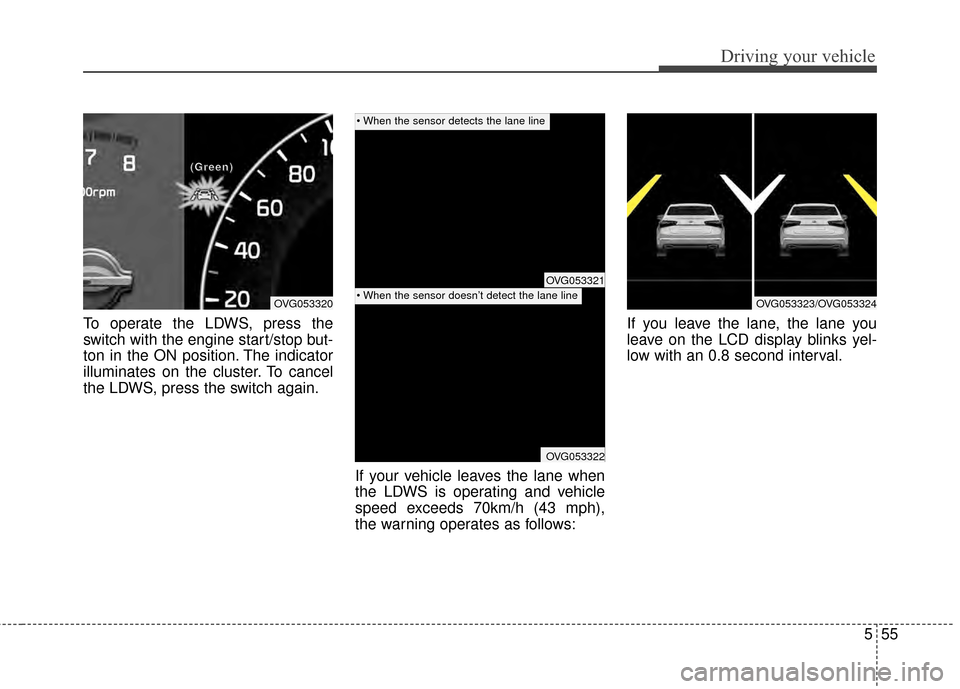
555
Driving your vehicle
To operate the LDWS, press the
switch with the engine start/stop but-
ton in the ON position. The indicator
illuminates on the cluster. To cancel
the LDWS, press the switch again.If your vehicle leaves the lane when
the LDWS is operating and vehicle
speed exceeds 70km/h (43 mph),
the warning operates as follows:If you leave the lane, the lane you
leave on the LCD display blinks yel-
low with an 0.8 second interval.
OVG053320
(
(
(
(
G
G
G
G
r
r
r
r
e
e
e
e
e
e
e
e
n
n
n
n
)
)
)
)
OVG053321
OVG053322
OVG053323/OVG053324
Page 283 of 429

Driving your vehicle
56
5
Warning indicator
If the LDWS fails, the warning indica-
tor comes on indicating the LDWS is
not working properly. Take your vehi-
cle to an authorized Kia Premium
dealer and have the system
checked.
The LDWS does not operate
when:
The driver turns on the turn signal
to change lanes.
(When the hazard warning flasher
is operated, the LDWS operates
normally.)
Driving on the lane line.
✽ ✽ NOTICE
To change lanes, operate the turn
signal switch then change the lane.
The LDWS may not warn you
even if the vehicle leaves the
lane, or may warn you even if
the vehicle does not leave the
lane when;
The lane can't be visible due to
snow, rain, stain, a puddle or many
other things.
The brightness outside changes suddenly.
The headlights are off at night or in a tunnel.
The color of the lane marking from the road is difficult to distinguish.
Driving on a steep grade or a curve.
Light reflects from the water on the road.
The lens or windshield is stained with foreign matter.
The sensor can't detect the lane because of fog, heavy rain or
heavy snow.
The surrounding of the inside rear view mirror temperature is high
due to a direct sun light.
OVG053320N
(
(
(
(
Y
Y
Y
Y
e
e
e
e
l
l
l
l
l
l
l
l
o
o
o
o
w
w
w
w
)
)
)
)
WARNING - LDWS
Limitations
The lane departure warning
system is a supplemental sys-
tem. Do not solely rely on the
system but always pay attention
and drive safely.
Page 284 of 429
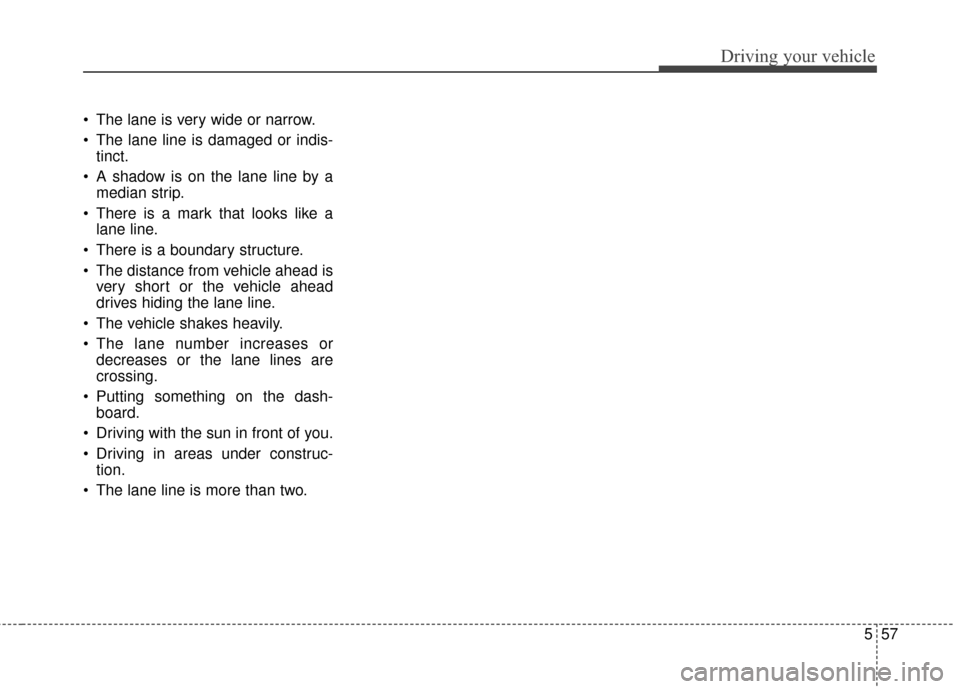
557
Driving your vehicle
The lane is very wide or narrow.
The lane line is damaged or indis-tinct.
A shadow is on the lane line by a median strip.
There is a mark that looks like a lane line.
There is a boundary structure.
The distance from vehicle ahead is very short or the vehicle ahead
drives hiding the lane line.
The vehicle shakes heavily.
The lane number increases or decreases or the lane lines are
crossing.
Putting something on the dash- board.
Driving with the sun in front of you.
Driving in areas under construc- tion.
The lane line is more than two.
Page 285 of 429

Driving your vehicle
58
5
The BSD (Blind spot detection) sys-
tem uses a radar sensor to alert the
driver while driving. It senses the rear side territory of the
vehicle and provides information to
the driver.
➀
BSD(Blind spot detection)
Warning range is dependent on your
vehicle speed. However, if your vehi-
cle speed is about 15 km/h (9.3 mph)
faster than the other vehicle, the sys-
tem will not warn you.
➁ LCA(Lane change assist)
When the vehicle is approaching to
your vehicle at high speed, the warn-
ing is operated.
BLIND SPOT DETECTION SYSTEM (BSD) (IF EQUIPPED)
OVG053325L
OXMA053126
WARNING- BSD Limitations
The Blind Spot Detection System (BSD) is a supplemen-
tal system. Do not solely rely
on the system but always pay
attention to drive safely.
The Blind Spot Detection System may not detect every
object alongside the vehicle
and is not a substitute for
proper and safe lane chang-
ing procedures. Always drive
safely and use caution when
changing lanes.
Page 286 of 429
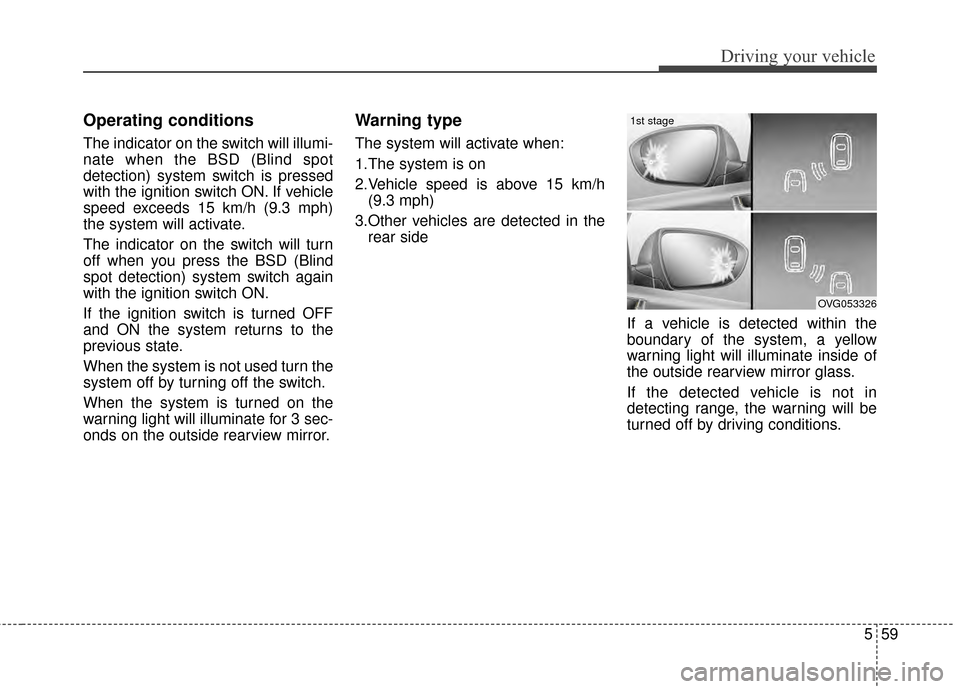
559
Driving your vehicle
Operating conditions
The indicator on the switch will illumi-
nate when the BSD (Blind spot
detection) system switch is pressed
with the ignition switch ON. If vehicle
speed exceeds 15 km/h (9.3 mph)
the system will activate.
The indicator on the switch will turn
off when you press the BSD (Blind
spot detection) system switch again
with the ignition switch ON.
If the ignition switch is turned OFF
and ON the system returns to the
previous state.
When the system is not used turn the
system off by turning off the switch.
When the system is turned on the
warning light will illuminate for 3 sec-
onds on the outside rearview mirror.
Warning type
The system will activate when:
1.The system is on
2.Vehicle speed is above 15 km/h(9.3 mph)
3.Other vehicles are detected in the rear side
If a vehicle is detected within the
boundary of the system, a yellow
warning light will illuminate inside of
the outside rearview mirror glass.
If the detected vehicle is not in
detecting range, the warning will be
turned off by driving conditions.
OVG053326
1st stage
Page 287 of 429
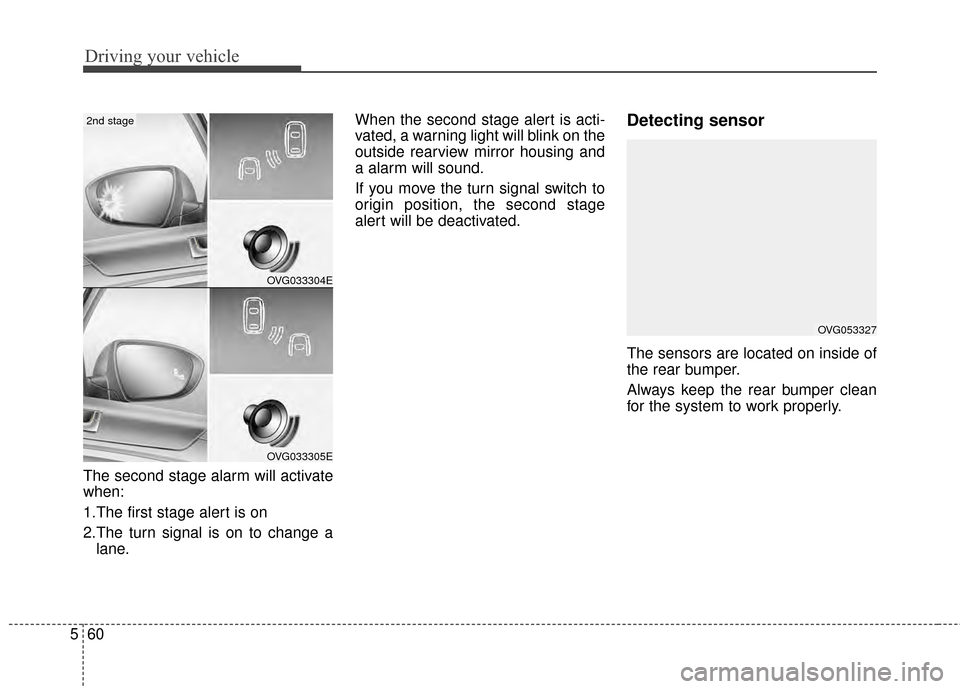
Driving your vehicle
60
5
The second stage alarm will activate
when:
1.The first stage alert is on
2.The turn signal is on to change a
lane. When the second stage alert is acti-
vated, a warning light will blink on the
outside rearview mirror housing and
a alarm will sound.
If you move the turn signal switch to
origin position, the second stage
alert will be deactivated.
Detecting sensor
The sensors are located on inside of
the rear bumper.
Always keep the rear bumper clean
for the system to work properly.
OVG053327
OVG033304E
OVG033305E
2nd stage
Page 288 of 429

561
Driving your vehicle
Warning message
If the system does not work properly,
a warning message will appear and
the light on the switch will turn off.
The system will turn off automatical-
ly.
Have your vehicle inspected by an
authorized Kia Premium dealer.
Non-operating condition
Driver's Attention
The driver must be cautious in the
following situations in which the sys-
tem may not assist the driver and
may not function properly.
- Curved roads, tollgates, etc.
- The surrounding of the sensor iscovered by rain, snow, mud, etc
- The rear bumper near the sensor is covered or hidden with a foreign
matter such as a sticker, bumper
guard, bicycle stand etc.
- The rear bumper is damaged or the sensor is out of place.
- The height of the vehicle is changed or altered such as when
the trunk is loaded with heavy
objects, or has abnormal tire pres-
sure etc.
- Due to bad weather such as heavy rain or snow.
OVG053328E
CAUTION
The system may not work properly if the bumper hasbeen replaced or if repair workhas been done near the sen-sor.
The detection area differs according to the roads width.If the road is narrow the sys-tem may detect other vehiclesin the next lane.
To the contrary, if the road is very wide the system may notdetect other vehicles.
The system may turn off due to strong electromagneticwaves.
Page 289 of 429
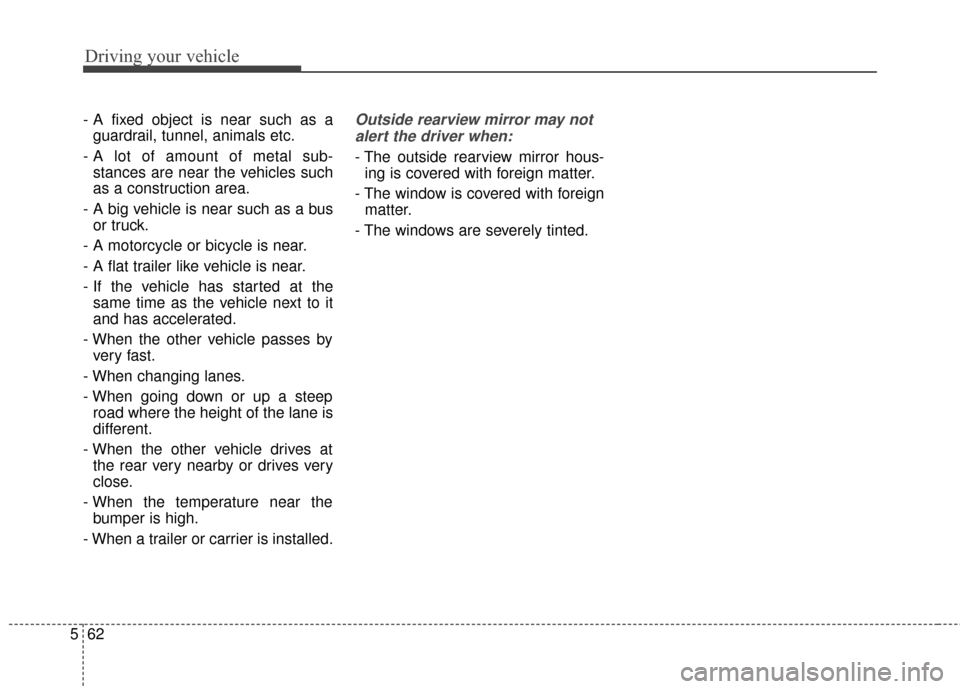
Driving your vehicle
62
5
- A fixed object is near such as a
guardrail, tunnel, animals etc.
- A lot of amount of metal sub- stances are near the vehicles such
as a construction area.
- A big vehicle is near such as a bus or truck.
- A motorcycle or bicycle is near.
- A flat trailer like vehicle is near.
- If the vehicle has started at the same time as the vehicle next to it
and has accelerated.
- When the other vehicle passes by very fast.
- When changing lanes.
- When going down or up a steep road where the height of the lane is
different.
- When the other vehicle drives at the rear very nearby or drives very
close.
- When the temperature near the bumper is high.
- When a trailer or carrier is installed.Outside rearview mirror may not alert the driver when:
- The outside rearview mirror hous- ing is covered with foreign matter.
- The window is covered with foreign matter.
- The windows are severely tinted.
Page 290 of 429
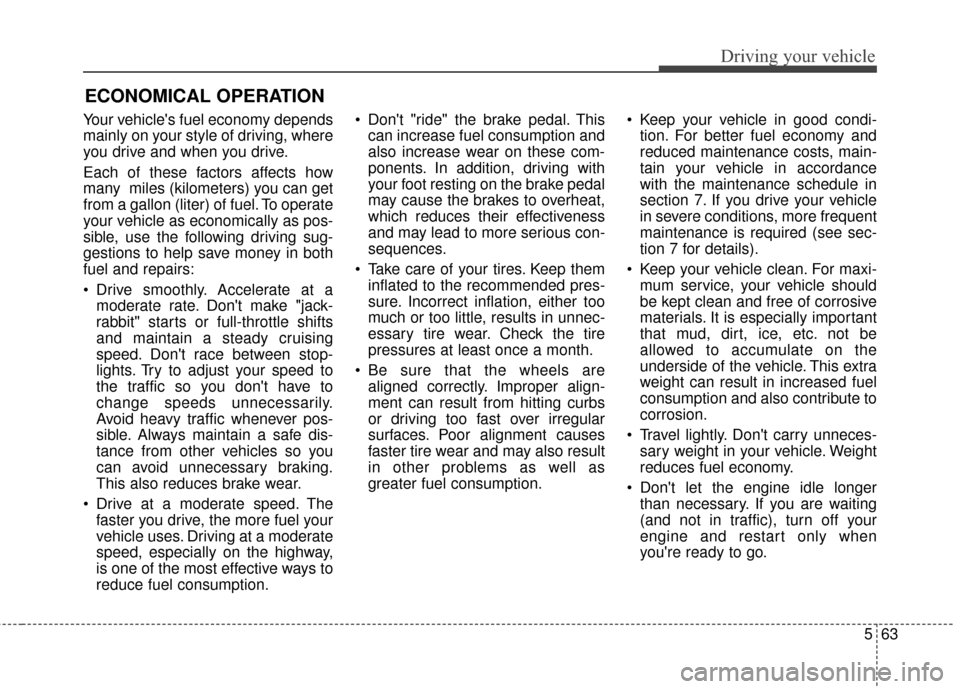
563
Driving your vehicle
ECONOMICAL OPERATION
Your vehicle's fuel economy depends
mainly on your style of driving, where
you drive and when you drive.
Each of these factors affects how
many miles (kilometers) you can get
from a gallon (liter) of fuel. To operate
your vehicle as economically as pos-
sible, use the following driving sug-
gestions to help save money in both
fuel and repairs:
Drive smoothly. Accelerate at amoderate rate. Don't make "jack-
rabbit" starts or full-throttle shifts
and maintain a steady cruising
speed. Don't race between stop-
lights. Try to adjust your speed to
the traffic so you don't have to
change speeds unnecessarily.
Avoid heavy traffic whenever pos-
sible. Always maintain a safe dis-
tance from other vehicles so you
can avoid unnecessary braking.
This also reduces brake wear.
Drive at a moderate speed. The faster you drive, the more fuel your
vehicle uses. Driving at a moderate
speed, especially on the highway,
is one of the most effective ways to
reduce fuel consumption. Don't "ride" the brake pedal. This
can increase fuel consumption and
also increase wear on these com-
ponents. In addition, driving with
your foot resting on the brake pedal
may cause the brakes to overheat,
which reduces their effectiveness
and may lead to more serious con-
sequences.
Take care of your tires. Keep them inflated to the recommended pres-
sure. Incorrect inflation, either too
much or too little, results in unnec-
essary tire wear. Check the tire
pressures at least once a month.
Be sure that the wheels are aligned correctly. Improper align-
ment can result from hitting curbs
or driving too fast over irregular
surfaces. Poor alignment causes
faster tire wear and may also result
in other problems as well as
greater fuel consumption. Keep your vehicle in good condi-
tion. For better fuel economy and
reduced maintenance costs, main-
tain your vehicle in accordance
with the maintenance schedule in
section 7. If you drive your vehicle
in severe conditions, more frequent
maintenance is required (see sec-
tion 7 for details).
Keep your vehicle clean. For maxi- mum service, your vehicle should
be kept clean and free of corrosive
materials. It is especially important
that mud, dirt, ice, etc. not be
allowed to accumulate on the
underside of the vehicle. This extra
weight can result in increased fuel
consumption and also contribute to
corrosion.
Travel lightly. Don't carry unneces- sary weight in your vehicle. Weight
reduces fuel economy.
Don't let the engine idle longer than necessary. If you are waiting
(and not in traffic), turn off your
engine and restart only when
you're ready to go.